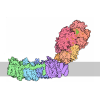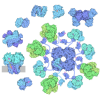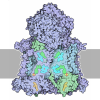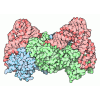+ データを開く
データを開く
- 基本情報
基本情報
| 登録情報 | データベース: PDB / ID: 8uem | ||||||
|---|---|---|---|---|---|---|---|
| タイトル | The CryoEM structure of the high affinity Carbon monoxide dehydrogenase from Mycobacterium smegmatis | ||||||
 要素 要素 |
| ||||||
 キーワード キーワード | OXIDOREDUCTASE / Carbon monoxide dehydrogenase / MoCu / Mycobacterium smegmatis / High affinity / trace gas scavenging | ||||||
| 機能・相同性 |  機能・相同性情報 機能・相同性情報carbon-monoxide dehydrogenase (acceptor) / anaerobic carbon-monoxide dehydrogenase activity / molybdenum ion binding / FAD binding / 2 iron, 2 sulfur cluster binding / oxidoreductase activity / iron ion binding / copper ion binding / metal ion binding 類似検索 - 分子機能 | ||||||
| 生物種 |  Mycolicibacterium smegmatis MC2 155 (バクテリア) Mycolicibacterium smegmatis MC2 155 (バクテリア) | ||||||
| 手法 | 電子顕微鏡法 / 単粒子再構成法 / クライオ電子顕微鏡法 / 解像度: 1.85 Å | ||||||
 データ登録者 データ登録者 | Grinter, R. / Venugopal, H. / Greening, C. / Gillett, D. | ||||||
| 資金援助 |  オーストラリア, 1件 オーストラリア, 1件
| ||||||
 引用 引用 |  ジャーナル: Nat Chem Biol / 年: 2025 ジャーナル: Nat Chem Biol / 年: 2025タイトル: Quinone extraction drives atmospheric carbon monoxide oxidation in bacteria. 著者: Ashleigh Kropp / David L Gillett / Hari Venugopal / Miguel A Gonzálvez / James P Lingford / Surbhi Jain / Christopher K Barlow / Jie Zhang / Chris Greening / Rhys Grinter /   要旨: Diverse bacteria and archaea use atmospheric CO as an energy source for long-term survival. Bacteria use [MoCu]-CO dehydrogenases (Mo-CODH) to convert atmospheric CO to carbon dioxide, transferring ...Diverse bacteria and archaea use atmospheric CO as an energy source for long-term survival. Bacteria use [MoCu]-CO dehydrogenases (Mo-CODH) to convert atmospheric CO to carbon dioxide, transferring the obtained electrons to the aerobic respiratory chain. However, it is unknown how these enzymes oxidize CO at low concentrations and interact with the respiratory chain. Here, we use cryo-electron microscopy and structural modeling to show how Mo-CODH (CoxSML) from Mycobacterium smegmatis interacts with its partner, the membrane-bound menaquinone-binding protein CoxG. We provide electrochemical, biochemical and genetic evidence that Mo-CODH transfers CO-derived electrons to the aerobic respiratory chain through CoxG. Lastly, we show that Mo-CODH and CoxG genetically and structurally associate in diverse bacteria and archaea. These findings reveal the basis of the biogeochemically and ecologically important process of atmospheric CO oxidation, while demonstrating that long-range quinone transport is a general mechanism of energy conservation, which convergently evolved on multiple occasions. | ||||||
| 履歴 |
|
- 構造の表示
構造の表示
| 構造ビューア | 分子:  Molmil Molmil Jmol/JSmol Jmol/JSmol |
|---|
- ダウンロードとリンク
ダウンロードとリンク
- ダウンロード
ダウンロード
| PDBx/mmCIF形式 |  8uem.cif.gz 8uem.cif.gz | 489.7 KB | 表示 |  PDBx/mmCIF形式 PDBx/mmCIF形式 |
|---|---|---|---|---|
| PDB形式 |  pdb8uem.ent.gz pdb8uem.ent.gz | 389.2 KB | 表示 |  PDB形式 PDB形式 |
| PDBx/mmJSON形式 |  8uem.json.gz 8uem.json.gz | ツリー表示 |  PDBx/mmJSON形式 PDBx/mmJSON形式 | |
| その他 |  その他のダウンロード その他のダウンロード |
-検証レポート
| 文書・要旨 |  8uem_validation.pdf.gz 8uem_validation.pdf.gz | 1.7 MB | 表示 |  wwPDB検証レポート wwPDB検証レポート |
|---|---|---|---|---|
| 文書・詳細版 |  8uem_full_validation.pdf.gz 8uem_full_validation.pdf.gz | 1.8 MB | 表示 | |
| XML形式データ |  8uem_validation.xml.gz 8uem_validation.xml.gz | 86.4 KB | 表示 | |
| CIF形式データ |  8uem_validation.cif.gz 8uem_validation.cif.gz | 135.7 KB | 表示 | |
| アーカイブディレクトリ |  https://data.pdbj.org/pub/pdb/validation_reports/ue/8uem https://data.pdbj.org/pub/pdb/validation_reports/ue/8uem ftp://data.pdbj.org/pub/pdb/validation_reports/ue/8uem ftp://data.pdbj.org/pub/pdb/validation_reports/ue/8uem | HTTPS FTP |
-関連構造データ
| 関連構造データ |  42164MC  8udsC C: 同じ文献を引用 ( M: このデータのモデリングに利用したマップデータ |
|---|---|
| 類似構造データ | 類似検索 - 機能・相同性  F&H 検索 F&H 検索 |
- リンク
リンク
- 集合体
集合体
| 登録構造単位 | 
|
|---|---|
| 1 |
|
- 要素
要素
-Carbon monoxide dehydrogenase ... , 2種, 4分子 ADBE
| #1: タンパク質 | 分子量: 85957.844 Da / 分子数: 2 / 由来タイプ: 天然 由来: (天然)  Mycolicibacterium smegmatis MC2 155 (バクテリア) Mycolicibacterium smegmatis MC2 155 (バクテリア)参照: UniProt: I7F6J6 #2: タンパク質 | 分子量: 31710.051 Da / 分子数: 2 / 由来タイプ: 天然 由来: (天然)  Mycolicibacterium smegmatis MC2 155 (バクテリア) Mycolicibacterium smegmatis MC2 155 (バクテリア)参照: UniProt: A0QQG2 |
|---|
-タンパク質 , 1種, 2分子 CF
| #3: タンパク質 | 分子量: 17148.570 Da / 分子数: 2 / 由来タイプ: 天然 由来: (天然)  Mycolicibacterium smegmatis MC2 155 (バクテリア) Mycolicibacterium smegmatis MC2 155 (バクテリア)参照: UniProt: A0QQG3 |
|---|
-非ポリマー , 5種, 909分子 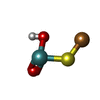

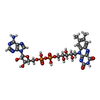
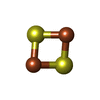
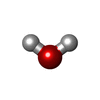




| #4: 化合物 | | #5: 化合物 | #6: 化合物 | #7: 化合物 | ChemComp-FES / #8: 水 | ChemComp-HOH / | |
|---|
-詳細
| 研究の焦点であるリガンドがあるか | Y |
|---|---|
| Has protein modification | N |
-実験情報
-実験
| 実験 | 手法: 電子顕微鏡法 |
|---|---|
| EM実験 | 試料の集合状態: PARTICLE / 3次元再構成法: 単粒子再構成法 |
- 試料調製
試料調製
| 構成要素 | 名称: MoCu Carbon monoxide Dehydrogenase (MoCu-CODH) / タイプ: COMPLEX / Entity ID: #2-#3 / 由来: NATURAL | |||||||||||||||
|---|---|---|---|---|---|---|---|---|---|---|---|---|---|---|---|---|
| 分子量 | 値: 0.270 MDa / 実験値: YES | |||||||||||||||
| 由来(天然) | 生物種:  Mycolicibacterium smegmatis MC2 155 (バクテリア) Mycolicibacterium smegmatis MC2 155 (バクテリア) | |||||||||||||||
| 緩衝液 | pH: 7.9 | |||||||||||||||
| 緩衝液成分 |
| |||||||||||||||
| 試料 | 包埋: NO / シャドウイング: NO / 染色: NO / 凍結: YES | |||||||||||||||
| 試料支持 | グリッドの材料: GOLD / グリッドのサイズ: 400 divisions/in. / グリッドのタイプ: Quantifoil R2/4 | |||||||||||||||
| 急速凍結 | 装置: FEI VITROBOT MARK III / 凍結剤: PROPANE / 湿度: 100 % / 凍結前の試料温度: 277 K |
- 電子顕微鏡撮影
電子顕微鏡撮影
| 実験機器 |  モデル: Titan Krios / 画像提供: FEI Company |
|---|---|
| 顕微鏡 | モデル: FEI TITAN KRIOS |
| 電子銃 | 電子線源:  FIELD EMISSION GUN / 加速電圧: 300 kV / 照射モード: SPOT SCAN FIELD EMISSION GUN / 加速電圧: 300 kV / 照射モード: SPOT SCAN |
| 電子レンズ | モード: DARK FIELD / 最大 デフォーカス(公称値): 1200 nm / 最小 デフォーカス(公称値): 300 nm |
| 撮影 | 電子線照射量: 66 e/Å2 / 検出モード: COUNTING フィルム・検出器のモデル: FEI FALCON III (4k x 4k) 撮影したグリッド数: 1 / 実像数: 4508 |
- 解析
解析
| EMソフトウェア |
| ||||||||||||||||||||||||||||||||||||
|---|---|---|---|---|---|---|---|---|---|---|---|---|---|---|---|---|---|---|---|---|---|---|---|---|---|---|---|---|---|---|---|---|---|---|---|---|---|
| CTF補正 | タイプ: PHASE FLIPPING AND AMPLITUDE CORRECTION | ||||||||||||||||||||||||||||||||||||
| 対称性 | 点対称性: C2 (2回回転対称) | ||||||||||||||||||||||||||||||||||||
| 3次元再構成 | 解像度: 1.85 Å / 解像度の算出法: FSC 0.143 CUT-OFF / 粒子像の数: 290597 / アルゴリズム: EXACT BACK PROJECTION / クラス平均像の数: 1 / 対称性のタイプ: POINT | ||||||||||||||||||||||||||||||||||||
| 原子モデル構築 | プロトコル: FLEXIBLE FIT / 空間: REAL / Target criteria: Cross-correlation coefficient | ||||||||||||||||||||||||||||||||||||
| 原子モデル構築 | Source name: AlphaFold / タイプ: in silico model |
 ムービー
ムービー コントローラー
コントローラー



 PDBj
PDBj
